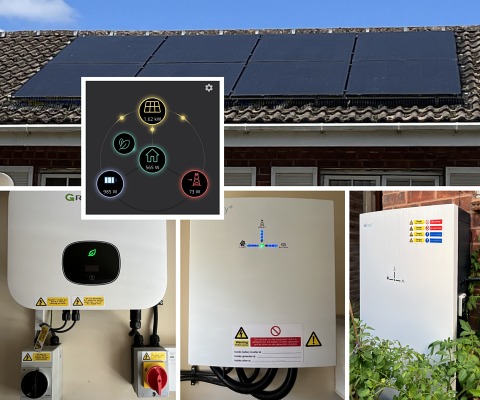Going Solar
by John Robinson; first published 26-Jul-2024

Some of the installed equipment - photos by Geoff Rogers
When my old mate Geoff announced that he'd installed domestic solar panels and a storage battery, I was intrigued to find out how it all worked. Using clean energy from the sun or the wind is good for the planet - but could it save money too? I wanted an honest appraisal.
The eight solar panels, on a south-facing roof, generate some power even on a cloudy day - but they'll top 3kW in sunshine. That's split between supplying the home (through a 230V "inverter") and charging the battery. Any surplus can be exported into the grid; the payback this earns is less generous than it was under the old "feed-in tariff", so it's worth retaining as much as possible in a large-capacity (13.5kWh) battery. The latter is the latest LFP (Lithium ferrophosphate) type, with a long life and a good safety record. It's also comparatively good for the environment, as it doesn't contain cobalt or nickel. By storing solar power for use overnight, it significantly reduces energy bills, especially during the summer. And of course it'll keep the house running in the event of a mains outage!
Pictured are (clockwise from top) the solar panels, the battery (outside), the "energy gateway" (controller), and the 230V inverter. Inset is a smartphone app display, showing how much power is coming from the panels, and how much is flowing to or from the battery and the grid. Owners of smart meters or electric vehicles will be familiar with graphics like this! Timed changes can be programmed - for example, to top up the battery overnight with cheap-rate mains power if no sun is expected on the following day. All the settings can be accessed, and status monitored, via the internet when the family are away from home.
All in all, Geoff is well pleased with the system. Installation took around three days, but it didn't cause much disruption as it was mainly drilling holes and running cables. The electricity was only turned off for 15 minutes, for the final switch-over. The project wasn't cheap - it may take 15 years to pay for itself in energy savings - but it's given the family a feeling of resilience and security, at a time of fluctuating energy prices. And an unexpected bonus is that surplus energy can sometimes be used to charge their electric car, effectively giving free travel!
![[Earth icon]](../emblem64.jpg)